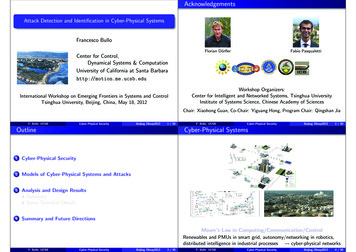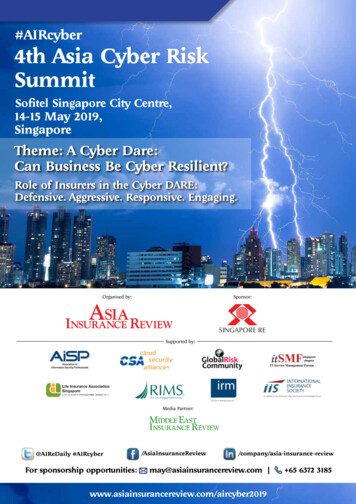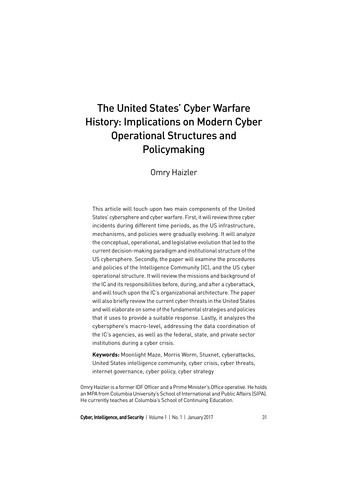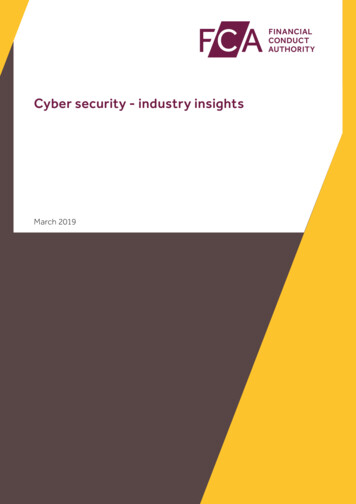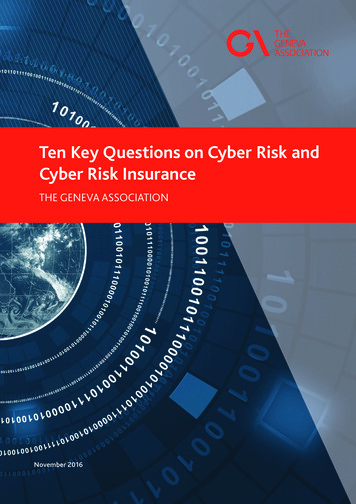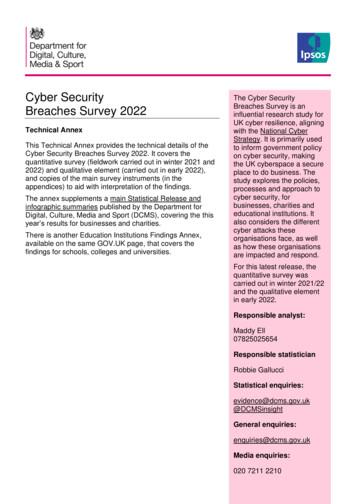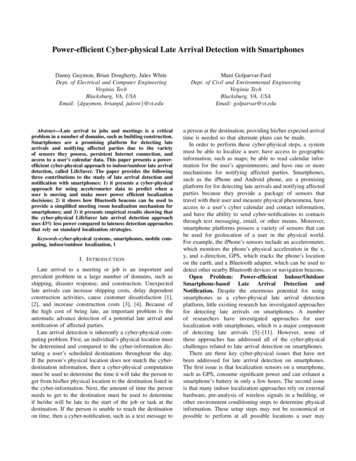
Transcription
Power-efficient Cyber-physical Late Arrival Detection with SmartphonesDanny Guymon, Brian Dougherty, Jules WhiteDept. of Electrical and Computer EngineeringVirginia TechBlacksburg, VA, USAEmail: {dguymon, brianpd, julesw}@vt.eduAbstract—Late arrival to jobs and meetings is a criticalproblem in a number of domains, such as building construction.Smartphones are a promising platform for detecting latearrivals and notifying affected parties due to the varietyof sensors they possess, persistent Internet connection, andaccess to a user’s calendar data. This paper presents a powerefficient cyber-physical approach to indoor/outdoor late arrivaldetection, called LifeSaver. The paper provides the followingthree contributions to the study of late arrival detection andnotification with smartphones: 1) it presents a cyber-physicalapproach for using accelerometer data to predict when auser is moving and make more power efficient localizationdecisions; 2) it shows how Bluetooth beacons can be used toprovide a simplified meeting room localization mechanism forsmartphones; and 3) it presents empirical results showing thatthe cyber-physical LifeSaver late arrival detection approachuses 43% less power compared to lateness detection approachesthat rely on standard localization strategies.Keywords-cyber-physical systems, smartphones, mobile computing, indoor/outdoor localization, lI. I NTRODUCTIONLate arrival to a meeting or job is an important andprevalent problem in a large number of domains, such asshipping, disaster response, and construction. Unexpectedlate arrivals can increase shipping costs, delay dependentconstruction activities, cause customer dissatisfaction [1],[2], and increase construction costs [3], [4]. Because ofthe high cost of being late, an important problem is theautomatic advance detection of a potential late arrival andnotification of affected parties.Late arrival detection is inherently a cyber-physical computing problem. First, an individual’s physical location mustbe determined and compared to the cyber-information dictating a user’s scheduled destinations throughout the day.If the person’s physical location does not match the cyberdestination information, then a cyber-physical computationmust be used to determine the time it will take the person toget from his/her physical location to the destination listed inthe cyber-information. Next, the amount of time the personneeds to get to the destination must be used to determineif he/she will be late to the start of the job or task at thedestination. If the person is unable to reach the destinationon time, then a cyber-notification, such as a text message toMani Golparvar-FardDept. of Civil and Environmental EngineeringVirginia TechBlacksburg, VA, USAEmail: golparvar@vt.edua person at the destination, providing his/her expected arrivaltime is needed so that alternate plans can be made.In order to perform these cyber-physical steps, a systemmust be able to localize a user; have access to geographicinformation, such as maps; be able to read calendar information for the user’s appointments; and have one or moremechanisms for notifying affected parties. Smartphones,such as the iPhone and Android phone, are a promisingplatform for for detecting late arrivals and notifying affectedparties because they provide a package of sensors thattravel with their user and measure physical phenomena, haveaccess to a user’s cyber calendar and contact information,and have the ability to send cyber-notifications to contactsthrough text messaging, email, or other means. Moreover,smartphone platforms possess a variety of sensors that canbe used for geolocation of a user in the physical world.For example, the iPhone’s sensors include an accelerometer,which monitors the phone’s physical acceleration in the x,y, and z-direction, GPS, which tracks the phone’s locationon the earth, and a Bluetooth adapter, which can be used todetect other nearby Bluetooth devices or navigation beacons.Open Problem: Power-efficient Indoor/OutdoorSmartphone-based Late Arrival Detection andNotification. Despite the enormous potential for usingsmartphones as a cyber-physical late arrival detectionplatform, little existing research has investigated approachesfor detecting late arrivals on smartphones. A numberof researchers have investigated approaches for userlocalization with smartphones, which is a major componentof detecting late arrivals [5]–[11]. However, none ofthese approaches has addressed all of the cyber-physicalchallenges related to late arrival detection on smartphones.There are three key cyber-physical issues that have notbeen addressed for late arrival detection on smartphones.The first issue is that localization sensors on a smartphone,such as GPS, consume significant power and can exhaust asmartphone’s battery in only a few hours. The second issueis that many indoor localization approaches rely on externalhardware, pre-analysis of wireless signals in a building, orother environment conditioning steps to determine physicalinformation. These setup steps may not be economical orpossible to perform at all possible locations a user may
travel through. The third issue of late arrival detection isthe requirement for both outdoor and indoor localization,which requires an approach that can seemlessly transitionbetween the different localization approaches used in eachenvironment.Solution Approach A Cyber-physical Approach forDetecting User Lateness. To fill this gap in research onsmartphone-based cyber-physical late arrival detection, wehave developed a smartphone-based late arrival detectionand notification approach called LifeSaver. LifeSaver usesa combination of smartphone sensors to determine a user’sphysical context, more intelligently power cycle localizationsensors, and significantly reduce the power required to detecta late arrival. Moreover, LifeSaver uses a key insight fromthe domain of late arrival detection, that indoor localizationonly needs to determine if the user is in a meeting room,to simplify the indoor localization component of late arrivaldetection.A key attribute of the LifeSaver approach is that itrequires significantly less power to detect late arrivals than isrequired if existing localization approaches are relied upon.In Section V we present empirical data that we gatheredfrom experiments that tested the operation of LifeSaver andcompared its power consumption to late arrival detectionwith existing localization approaches. Our empirical resultsshow that LifeSaver uses up to 42% less power than latearrival detection with existing localization approaches. Inaddition, our results show that LifeSaver is capable ofseamless indoor/outdoor localization.This paper provides the following contributions to thestudy of user late arrival detection with smartphones: We present a novel localization technique for mobiledevices that is capable of determining device locationseamlessly between indoor/outdoor environments without requiring additional preconfigured hardware. We provide a formal methodology for using smartphonesensors to acquire physical data, such as device locationand nearby device IDs, and relating it to cyber modelthat contains schedule data, such as appointment timeand location, to detect late arrivals. We present empirical results showing the impact ofGPS and Bluetooth localization on the power consumption of mobile devices. We show that the Lifesaver technique can delay performing localization based on sensor data, thereby conserving device power by reducing GPS and Bluetoothactivity.The remainder of this paper is organized as follows:Section II describes a practical scenario clarifying the mainobjectives of this research effort, which we use as a motivating example throughout the paper; Section III discusses thechallenges that we faced when addressing the two issuesfrom above; Section IV covers our solution to the overallproblem; Section V presents empirical results from thebenchmark experiments we ran; and Section VII presentsconcluding remarks and lessons learned.II. M OTIVATING E XAMPLEAs a motivating example to illustrate the challenges oflate arrival detection, we use a scenario from the constructionindustry. One type of construction late arrivals that we focuson in this paper is late contractor arrivals [12], which cancause significant delays and cost increases on a job site.Figure 1.Example Schedule of Dependent Construction TasksA critical issue on construction sites is that many construction tasks directly depend upon the completion of prior tasks.For example, as seen in Figure II, initial framing of walls isdependent upon the completion of the foundation. Often,however, contractors, such as plumbers will arrive late,delaying work on a construction task and leaving workersassigned to certain dependent tasks idle.If it was possible to predict when a contractor was goingto be late, workers could be assigned to alternative tasks thatare not directly dependent upon the late contractor. Studieshave shown that in a sample of 215 completed commercialand industrial construction projects, 62% of them werelate and 88% of these late projects had late contractors.A majority of the projects’ timelines to completion wereextended by a month, but in some extreme cases a six-monthextension was needed to finish the project [4]. A one tosix month increase in construction time can add significantexpense to a construction project [4].III. C HALLENGES OF C YBER - PHYSICAL L ATE A RRIVALD ETECTIONAlthough smartphones are a promising platform for userlate arrival detection, Smartphone late arrival detection mustaddress challenges related to the limited battery capacity ofsmartphones and issues associated with indoor localization.Because phones are usually only charged at the night whenthe user is asleep and many meetings occur indoors, powerefficiency is critical for developing a smartphone late arrivaldetection system. Moore’s Law defines the rate of advancement for certain computing attributes, such as processorspeed and storage density. However, battery power densityhas not increased nearly as fast as processor speed [13]. Theremainder of this section explores three key challenges of
power efficient indoor/outdoor user late arrival detection onsmartphones.A. Challenge 1: Power EfficiencyGPS is the primary mechanism for precise user localization using smartphones. A key challenge of detectinglate arrivals using smartphones is that smartphones havelimited battery capacities that can quickly be exhaustedusing smartphone localization sensors, such as GPS. Forexample, the iPhone 4, the Droid X and the Nexus One have1420 mWh, 1570 mWh and 1400 mWh battery capacity,respectively. A GPS sensor, alone, consumes roughly 140mW of power when enabled [14], so neglecting all otherpower consumption on the phone, the battery is expected tolast 10 - 11 hours for the iPhone, Droid X and Nexus Onewhen GPS is turned on. In reality, an active GPS sensor alsorequires CPU and other power consumptive resources. Whenthese other supporting resources are considered, battery lifemay be as short as 3-4 hours when GPS is enabled. Becauseusers normally charge their phones at night while they sleep,running GPS all of the time is not a feasible approach forlocalization.In the context of our construction scenario, described inSection II, the power consumption challenge becomes an issue when a late arrival detection application on the worker’ssmartphone uses up too much battery power throughout theday. The average construction worker’s shift is eight hours,so in order to benefit the construction domain, an algorithmmust not exhaust a smartphone’s battery in less than thisamount of time. Once the battery is depleted, late arrivaldetection of the smartphone’s owner comes to a halt until thebattery is recharged. Since most people recharge their phonesat night while sleeping, they are less likely to rechargetheir phone during the day at work on a construction site.Section IV describes how we address this challenge by usinga smartphone’s accelerometer to determine user context anintelligently enable and disable GPS and other localizationsensors to save power.B. Challenge 2: Indoor Localization to a Specific RoomWithout External HardwareThe second challenge of smartphone late arrival detectionis indoor localization without external hardware, such asBluetooth beacons, WiFi hotspots and GPS repeaters. Figure III-B shows the inadequacy of outdoor GPS localizationin an indoor environment due to physical barriers blockingsignals. Indoor localization is the process of monitoring aperson’s location in a building. For late arrival detection,indoor localization must be accurate enough to determine ifa user is in a specific meeting room.Many previous indoor localization approaches have reliedupon preconfigured external hardware, such as custom-madeBluetooth beacons or wireless routers and GPS repeaters,in order to track a user’s location indoors. Each of theseFigure 2.GPS Signals Blocked in a Construction Environmentapproaches requires preconfiguration of the indoor environment or additional hardware. For example, in WiFi localization approaches, the cell signals through the building mustbe mapped and the area of overlap between access pointsmeasured. In Bluetooth localization approaches, Bluetoothbeacons are laid about a floor plan requiring custom-madecontainers to focus the signal for increased detection range.In accelerometer-based indoor localization, floor plans aredownloaded to the mobile device and the user specifiesa starting location. Extra hardware increases the cost andpreconfiguration of the environment and may not be practical due to the lack of robustness and portability to otherenvironments.Referring back to our motivating example in Section II,construction workers already have a great deal of equipmentto use and keep track of, so the introduction of fragile andexpensive headsets or beacons for late arrival detection andlocalization would not be ideal in a construction site environment. Also, construction sites are dynamically changingand so approaches that rely on measurements of externalphysical phenomena, such as WiFi signals, would have to becontinually recalibrated as the building is built and the signalpropagation properties on the site changed. Section IV-Edescribes how we address this challenge by using the smartphone’s Bluetooth adapter for indoor localization withoutpreconfigured external hardware.C. Challenge 3: Seamless Indoor/Outdoor LocalizationTransitionsThe third challenge of user late arrival detection is thedifficulty in accomplishing seamless indoor/outdoor localization transitions. Seamless transitions are needed becausethey ensure continual location tracking regardless of the
changes in the surrounding environment. While there havebeen many research efforts focused on indoor and outdoorlocalization, there are very few that seek to accomplishseamless handoff between the two localization methods.One solution, called Streamspin, uses a combination ofGPS and WiFi hotspots to achieve seamless indoor/outdoorlocalization handoff on a mobile PDA device [15]. Eventhough Streamspin accomplished seamless indoor/outdoorlocalization transitions, the algorithm depended upon GPS,required preconfigured WiFi maps and consumed 35% ofthe device’s battery per hour, which would exhaust thebattery too quickly for many late arrival detection domains.We can see that this challenge is not mutually exclusivefrom the other two, thus making seamless indoor/outdoorlocalization that much more difficult to address. One maybe able to accomplish seamless localization handoff, but theaccomplishment comes at the expense of power consumptionand simplicty in design.Construction workers may walk in and out of the buildingduring construction. In order to be able to track the latearrivals of workers or of specific job-related tasks, it isnecessary to accomplish seamless indoor/outdoor localization handoff in a user late arrival detection algorithm. Forexample, a plumber is going to work on several constructionprojects in the same day. On some sites, he may be doingplumbing work inside a partially finished structure wherethe GPS fix on his location my be periodically lost andfound. At other parts of the day, he may be installingpipe as part of the foundation for a building and has acontinual GPS signal. A late arrival detection algorithmwith seamless localization would be able to keep track ofwhere the plumber was at any point of the day in orderto determine if he was running late to a job based uponhis work schedule. Section IV-D describes how we addressthis challenge by developing a GPS-based algorithm fordetecting indoor/outdoor localization handoff.battery power, LifeSaver uses a context-based approach topower GPS and Bluetooth sensors on and off.Indoor Localization Approach. Indoor meetings requirea smartphone to localize a user to a specific room to determine if the user has entered the meeting room. However,when a user is inside the building containing a meetingroom, it is typically not necessary to know exactly whichroom they are in. Once a user is in the building where ameeting is taking place, knowing whether the user is in thedesignated meeting room or not is sufficient. In most cases,the travel time within a building is insignificant.Because it is not necessary to know exactly where auser is within the building of a meeting location, LifeSaveruses a simple Bluetooth rendez-vous beacon to determinewhen a user has reached a meeting room. When the firstparticipant in a meeting reaches the designated meetingroom, they activate a Bluetooth beacon that broadcasts aunique ID assigned to each meeting. When the devicesof other participants in the meeting receive the Bluetoothbroadcast, they automatically assume that they have reachedthe meeting room. This localization approach is similar toprior Bluetooth-based indoor localization approaches, butdoes not require the installation of external hardware. Theapproach relies on the short range of Bluetooth communications to determine if a user has reached a meeting room.IV. S OLUTIONLifeSaver is a cyber-physical approach to late arrivaldetection with smartphones. LifeSaver uses a decision treeto drive a state-machine using physical events as inputsfor cyber decisions on the smartphone. LifeSaver addressesthe three challenges described in Section III: (1) lowpower consumption with an accelerometer-based algorithmto determine when to start localization, (2) relative indoorlocalization without extra preconfigured hardware beyondwhat’s available on the smartphone , and (3) seamlessindoor/outdoor localization handoff with a GPS-based algorithm. These challenges are overcome by LifeSaver throughthe use of two critical power efficiency and indoor localization techniques.Context-based Power Cycling. As described in Section III-A, power efficiency is a major challenge insmartphone-based late arrival detection. In order to conserveFigure 3.LifeSaver’s State-machine and Decision Tree
A. Formal Model of LifeSaver’s Cyber-physical Late ArrivalDetection AlgorithmLate arrival detection requires the processing of physicalstimulus data from a smartphone’s sensors, estimation of auser’s location/context, and determination of whether a userwill reach a meeting location by its start time. LifeSaver’slate arrival detection algorithm is based on a 6-tuple staterepresentation that encodes physical stimulus data and location/context estimation:Lsk tk , D(tk ), C(ti ), φ(ti ), ρ(ti ), σ(ti ) (1)where: tk T is the time of the future scheduled meeting Mk ,from the user’s calendar. The set of all future meetingtimes is T . D(tk ) is the latitude and longitude of the meeting, Mk ,at time tk . C(ti ) is the last known latitude and longitude of thedevice at time ti , where ti tk . φ(ti ) is a flag indicating whether or not the device isbelieved to be indoors or outdoors at time ti . If thedevice is indoors, φ(ti ) 1. ρ(ti ) is a flag indicating whether or not the deviceis believed to be currently moving. If the device isbelieved to be moving, ρ(ti ) 1. σ(ti ) is a flag indicating whether or not the device hasreceived a Bluetooth beacon signal from the device ofa user who has arrived at the meeting location. If thesignal has been received, σ(ti ) 1.Late arrival detection is modeled as a function, Late(Ls),where the determination of whether or not a user is late isbased on the device’s current location, the estimated timeto reach a future meeting location, and whether or not aBluetooth beacon signal has been received for the givenmeeting: ti (D(tk ), C(ti )) tk ζ α 0 ti (D(tk ), C(ti )) ǫ tk ζL(Mk ) σ(ti ) 1 ti (D(tk ), C(ti )) ζ tk otherwise00011(a),(b),(c)(d),(e)(2)where: Mk is a future meeting. ti is the current time on the user’s device. (D(tk ), C(ti )) that estimates the travel time fromthe user’s current last known location to the meetinglocation. ζ is a lateness threshold factor that determines howmany minutes past a meeting’s start time the user canarrive without being considered late. This factor canbe varied based on meeting importance, local customs,and other factors. α is a flag that indicates whether or not arriving at themeeting destination is sufficient to have arrived at themeeting or if the attendance requires reaching a specificroom. ǫ is a time allowance to walk from the entrance of abuilding to a meeting room. We use a fixed value for ǫ.In practice, ǫ will vary based on the building, howeverwe assume that in most cases ǫ is negligible and willnot make a substantial impact. If needed, this valuecould be dynamically assigned based on the buildingand room that the meeting is scheduled in.The LifeSaver late arrival detection algorithm considersa user to be on-time in three primary cases. In case (a),the meeting is not taking place indoors or within a specificroom (α 0) and the current time plus the travel timefrom the user’s current location to the meeting location isless than the meeting start time of the meeting (tk ). Case(b) focuses on situations in which the user has not reachedthe destination location yet and the meeting is occurring ina specific room. In this situation, if the user can reach thedestination location and walk to the room before the meetingstart time, the user is considered on-time. The final on-timecase, case (c), marks the user as being on-time because aBluetooth beacon signal for the meeting has been receivedfrom another attendant’s smartphone. In all other cases, theuser is expected to arrive late to the meeting.B. LifeSaver’s State-based Sensor Activation ModelThe first high-level component of LifeSaver is the statemachine, which is represented by the blue rectangles inFigure IV. The red diamonds are the decisions made by thedecision tree which we will discuss later. The state-machinehas five states: (1) appointment setup/application sleep,(2) accelerometer enabled, (3) GPS enabled, (4) Bluetoothenabled and (5) destination reached.State 1a: Appointment setup. State 1a involves thestart up of the application and the user scheduling anappointment in the phone by use of a time widget, suchas the prototype time widget used for our experiments andshown in Figure IV-C. Once the user selects the time ofthe appointment, the meeting data is stored for later useby the decision tree in the cyber model. Extraction ofgeolocation data from natural language was not a componentof the research presented in this paper. We assume thatappointments with GPS coordinates are available from aservice, such as Google Calendar. In our experiments, weused a destination specification widget to capture locationdata for appointments.State 1b: Sleep. Transitioning to State 1b is determinedby the decision tree in Decision 1 as seen in Figure IV. Ifthe decision tree determines that the application must sleep,then the main thread goes to sleep until the current time is
within γ minutes of the appointment time selected in State1a. For example, if the user scheduled an appointment for11:30 AM, γ 5min, and the current time is 11:05 AM,then the application would sleep for twenty minutes and thenwake back up at 11:25 AM. In our experiments, a buffer timeof five minutes was shown to effectively detect late arrivalsin most cases without excessively consuming battery power.State 2: Accelerometer on. An important energy savingstep of LifeSaver is that it attempts to only localize the user ifmovement is detected. The LifeSaver formal model capturesperceived motion in ρ(ti ). A smartphone’s accelerometer isused to calculate ρ(ti ).In State 2, the application is woken up and the smartphone’s accelerometer is enabled to record physical acceleration experienced by the phone caused by the user’smovement. For example, if the user is carrying the phoneas he/she walks around, the accelerometer will record thechanges in acceleration in the x, y, and z-direction. Thisphysical data is used by the decision tree to enable thelocalization sensors. LifeSaver uses a threshold functionbased on the total movement recorded over a configurableduration, β. If the recorded motion exceeds a threshold, thesmartphone is considered to be in motion and ρ(ti ) 1.Otherwise, ρ(ti ) 0.State 3: Accelerometer off/GPS on. At regular intervals,LifeSaver must attempt to determine the device’s currentlocation and update C(ti ). LifeSaver uses a smartphone’sGPS sensor to derive a location for C(ti ). GPS is also usedto make a determination of whether or not the device isindoors and assign φ(ti ).In State 3, the accelerometer is disabled and accelerationdata is no longer recorded since the decision tree has decidedthat the user is walking around. GPS is enabled on thesmartphone to establish an initial outdoor location fix. Oncea location fix is established, location updates are sent tothe smartphone periodically as the user walks to updateC(ti ). When a new location update is sent to the phone,a background count down timer is reset and initiated by thedecision tree. If this timer reaches zero, then the decisiontree determines that the user is no longer outside and hasentered a building (φ(ti ) 1).State 4: GPS off/Bluetooth on. For indoor meetinglocations, a Bluetooth rendez-vous scheme is used to detectwhen a user has reached the meeting location. The firstmeeting participant to enter the meeting location enablesa Bluetooth beacon on their device that broadcasts theunique ID of the meeting. When other devices discover thisBluetooth beacon, they update σ(ti ) to 1. The function σ(ti )serves as an indicator that the user has been localized to themeeting room.State 4 begins the Bluetooth discovery process to updateσ(ti ). This state is reached when the phone no longerreceives location updates causing the count down timer fromState 3 to reach zero. The smartphone’s GPS is disabled andthe Bluetooth adapter is turned on. The adapter is put intodiscovery mode to detect the meeting’s Bluetooth beacon.State 5: Devices found. In State 5, if the correct Bluetoothbroadcast is discovered, then the user is at the destination.C. Address Challenge 1: Conserving Power with Motionbased Sensor Power CyclingFigure 4.Main Screen of the LifeSaver ImplementationRather than immediately turning on the GPS to attemptto acquire a location fix, we took a more power conservative approach. When the application is sleeping, powerconsumption is at a minimum. Once the application wakesup, the accelerometer is activated to determine if the useris moving before the GPS is turned on to begin outdoorlocalization. The accelerometer provides data on the changesin the phone’s acceleration, and we equated roughly twentyseconds of continual accelerometer updates as evidence ofthe user walking around, assuming that he/she is headingtowards the destination by exiting the building. Once theaccelerometer detects these physical changes, the data isstored in the cyber application so that the decision tree canturn off the accelerometer and then enable GPS to establishan initial outdoor location fix.We used the accelerometer in this manner to shorten thetime we needed the GPS to establish an initial location fix.By default, the GPS on the smartphone does not have atimeout, meaning, if the phone’s GPS is on and the phoneis sitting on a desk somewhere inside a building, the phonewill continually attempt to connect to a satellite to establish alocation fix. Since this operation is costly in terms of power
consumption, delaying activation of the physical sensors,such as GPS and accelerometers, until the current time iswithin five minutes of the appointment time stored in thecyber model, can substantially reduce power consumption.The user confirms the appointment by pressing the confirm button which then transitions the state machine to State2 to put the application to sleep.D. Addressing Challenge 2: User Arrival Detection withBluetoothsecond challenge described in Section III-B. The secondchallenge involves the difficulty in providing accurate indoorlocalization down to a specific room without using preconfigured, external hardware. We used the Bluetooth adapteralready built into the smartphone to achieve relative indoorlocalization of the user. By discovering recognized Bluetoothdevices in the nearby area based upon device name andMAC address, we’re alleviated from the need of preciselocalization, which is hard to do without costly additionalhardware. When the adapter sees other Bluetooth devices,the decision tree determines if they are friends/co-workersE. Addressing Challenge 3: Detecting Outdoor-to-IndoorTransitionPreviously, in Section III-C we discussed the challenge ofseamless indoor/outdoor localization. The decision tree transitions the state-machine to State 3 by enabling the smartphone’s GPS after roughly twenty seconds of movementcaptured by the accelerometer. GPS serves two purposesonce it is activ
the cyber-physical LifeSaver late arrival detection approach uses 43% less power compared to lateness detection approach es that rely on standard localization strategies. Keywords-cyber-physical systems, smartphones, mobile com-puting, indoor/outdoor localization, l I. INTRODUCTION Late arrival to a meeting or job is an important and




